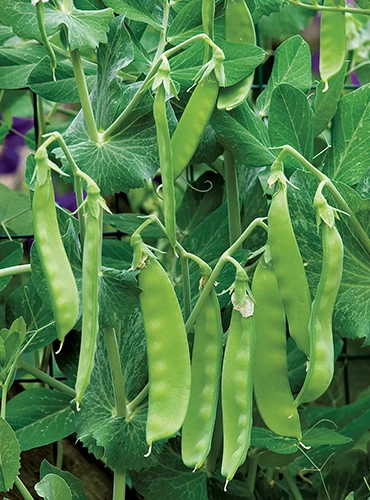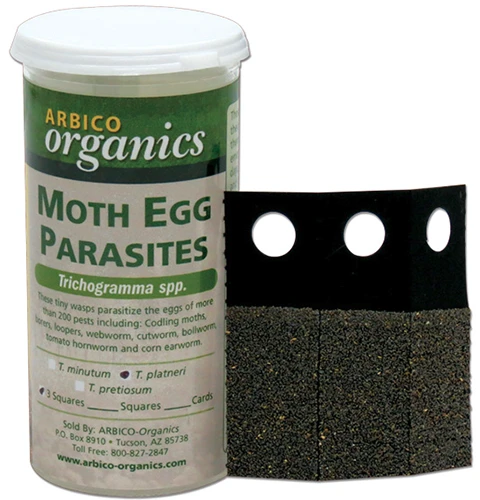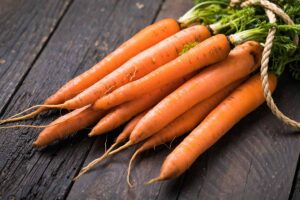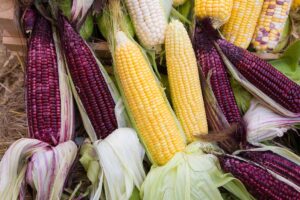Pisum sativum var. macrocarpon ‘Oregon Sugar Pod II’
Every plant breeder dreams of creating that perfect cultivar that has all the marvelous characteristics that they’re aiming for.
A cultivar that will win awards, make them rich, or gain them accolades from their fellow botanists.

We link to vendors to help you find relevant products. If you buy from one of our links, we may earn a commission.
The stellar ‘Oregon Sugar Pod II’ is one of those killer cultivars. It’s a sugar snap pea resistant to powdery mildew, fusarium wilt, and pea enation mosaic virus.
It grows quickly and produces incredibly tasty pods in a small footprint. The breeder wanted to create the perfect freezing pea and, by all accounts, they succeeded.
Unsurprisingly, given all of this to recommend it, it’s one of the most widely grown peas in North America today. And yet, it has never won an All-America Selections award, and the breeder didn’t make a single penny off it.
What’s up with that?
Whether you’re interested in growing this pea for a snack or for use in furthering a breeding program of your own, this guide will help you through all the ins and outs of what it takes to make it thrive.
Not that it’s all that difficult. Plus, we’ll talk about the history of how this plant came to be and why you won’t see it on that famous award list.
Here’s what we’re going to go over in this guide:
What You’ll Learn
Peas are pretty easy to grow if you can provide them with the cool weather they like. But this one is even easier.
The hardest part is figuring out how to eat all the delectable legumes you’ll be growing.
Don’t worry, we have some ideas for that, too. Here we go!
What Is the Oregon Sugar Pod Pea?
‘Oregon Sugar Pod II,’ also known as ‘Oregon Sugarpod II’ and ‘Oregon Sugar Pod 2,’ or commonly “Oregon Sugar Pod Pea,” is a cultivar of sugar snap (Pisum sativum var. macrocarpon).
The peas themselves are semi-wrinkled and sweet, and they form inside succulent, light green, edible pods that grow up to four inches long.
The plants grow up to 30 inches tall and mature in about 56 days, with pods that are sweet, tender, and stringless.
You can grow them anywhere with enough cool days, in USDA Hardiness Zones 3 to 10.
Cultivation and History
This tasty legume was developed in the 1980s in Dr. James R. Baggett’s long-running breeding program at Oregon State University.
Baggett also oversaw breeding of the ‘Cascadia’ and ‘Oregon Giant’ peas, ‘Honey Boat Delicata’ squash, ‘Summertime’ lettuce, and the ‘Oregon Spring’ tomato, the latter of which has saved many a Pacific Northwestern gardener who thought they’d never be able to grow a tomato successfully in a rainy, cool climate – including me.

“Oregon sugarpod,” another nickname, was bred as a complex cross over years using ‘Wando,’ ‘Perfected Freezer,’ and others, with the goal of making a perfect freezing pea that could resist some of the most common and devastating diseases that can affect Pisum plants.
Spoiler alert: mission accomplished.
Thanks to Baggett and his team’s efforts, this pea, which improved upon the larger ‘Oregon Sugar Pod,’ is one of the most popular edible-podded peas in the world.
Gardeners worldwide grow this pea, including those in the Pacific Northwest, who used to be relegated to just a few months of poor pea growing. This cultivar enabled them (and me!) to grow peas successfully from May until the first frost.
Baggett was encouraged by the university to put intellectual property restrictions on his creations, but he refused, believing plant genetic material should belong to everyone.
He and the university probably lost out on a lot of cash, recognition, and fame as a result of this, but he stuck to his guns.
As such, he was one of the American pioneers of projects like the Open Source Seed Initiative and other efforts to keep seeds and other plant material a part of the public domain.
Speaking of, many people look for the All-America Selections seal of approval when choosing cultivars, and you might notice that ‘Oregon Sugar Pod II’ never won the prestigious award. If it’s so fantastic, why was it never recognized?
That’s because the cultivar was never patented, so it was never submitted for review to the organization.
The AAS requires winners to pay a percentage back to them each year. If you aren’t making money off of your creations, it’s pretty hard to pay a percentage of the sales, right?
Don’t let that glaring absence scare you. This cultivar is a winner in every other way. Plus, since it isn’t patented, you can use it in your own propagation efforts.
Propagation
There’s a reason why peas are one of those crops that beginners often start with. They’re achingly easy to start, so long as you’re planting in the right temperatures.
You can sow these any time the weather is cool enough as long as it will remain cool for the two months you need for the plants to mature.
Temperatures need to be below 70°F primarily, so early spring and early fall are the best times.
A blip above 70°F is no big deal, but extended periods above that will cause the plants to flower and produce pods prematurely, or they may fail to flower altogether.
If you don’t have the time, buy seedlings to get a head start, or start the seeds indoors. With seedlings, you only need a few weeks to grow mature, ready-to-harvest pods. I told you it was easy, right?
From Seed
Because this cultivar is open-pollinated, you can use the seeds from the previous year to start plants the following year.
You’ll need to let the pods mature fully for this, so leave a few on the plant until they turn dry and brown.
You can also buy the seeds ready to go, of course. As one of the most popular cultivars, you can usually find them just about anywhere.
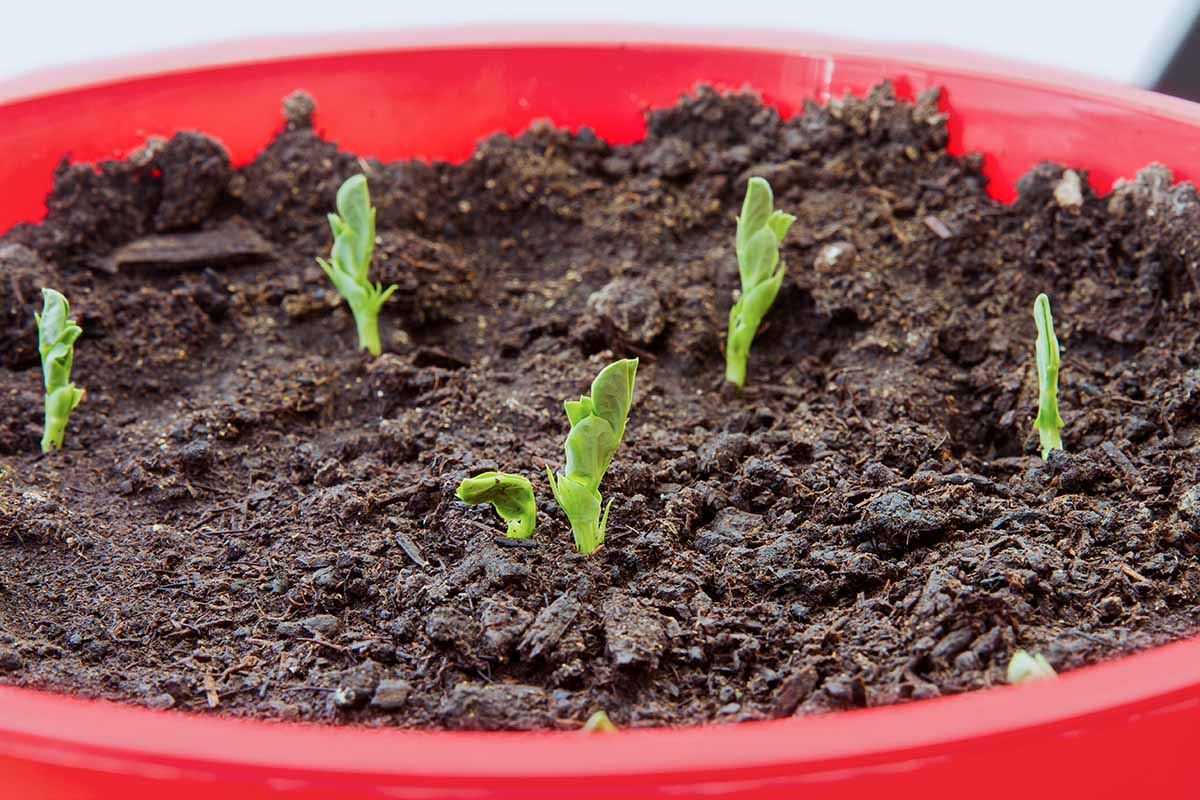
If you don’t have 55 days in a row of cool weather, feel free to start your plants indoors. Start seeds in three-inch pots filled with potting mix and poke one seed an inch deep in the center of each pot.
Water well so the soil is moist but not wet and place it somewhere the pots will receive six or more hours of sun.
Once the weather cooperates and the seedlings are a few inches tall, take them outside after a week of hardening them off.
Hardening off is the process of placing the seedlings outside in a protected spot for an hour and then bringing them back inside.
On day two, take the plant out for two hours. Day three, three hours, day four, four hours, and so on, until a week has passed.
Now you can stick them in the ground as described under the section on propagating seedlings below.
Outdoors, sow seeds an inch deep and two to three inches apart in loamy, rich soil. I don’t know about you, but my soil isn’t naturally like that. So work in plenty of well-rotted compost to make it that way if your soil is imperfect like mine.
Water well and keep the soil moist. Pea seeds take under two weeks to germinate.
From Seedlings
In most areas, you can find seedlings at stores in the spring. To plant them, dig a hole twice as wide and deep as the container that the seedling came in.
Then, fill the base back in, so the seedling sits as high as it was in the container.
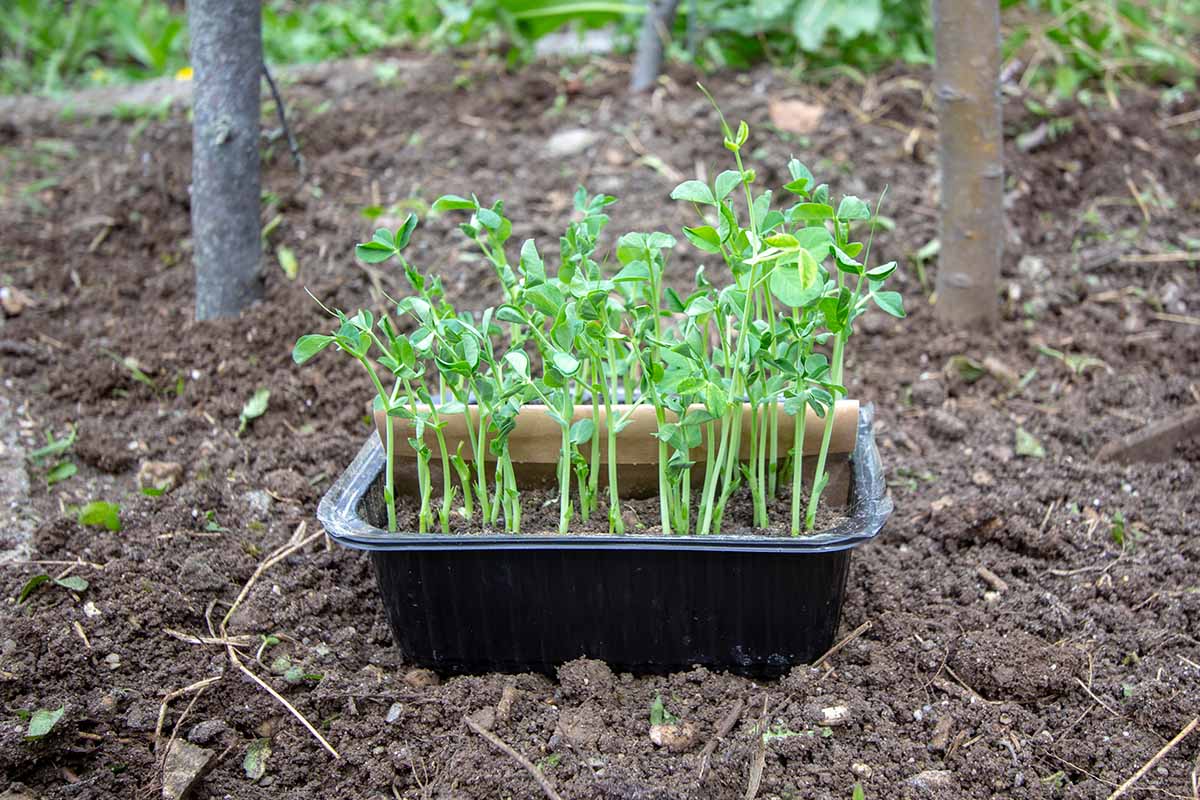
Place the seedling in the hole and fill in around it with soil. Water well so that the soil is moist but not soggy.
So long as the temperatures and sun exposure are right, you’ll have healthy, productive plants in a few weeks.
How to Grow
Peas do best in rich, loose, loamy soil with a pH between 5.5 and 7.0.
I don’t naturally have that kind of earth in my yard, and I’m guessing you don’t either. We can fake it by adding lots and lots of well-rotted compost to our soil. Compost loosens up clay and adds water retention to sandy soil.
You can grow these veggies much in the same way you would grow any other edible-pod pea.
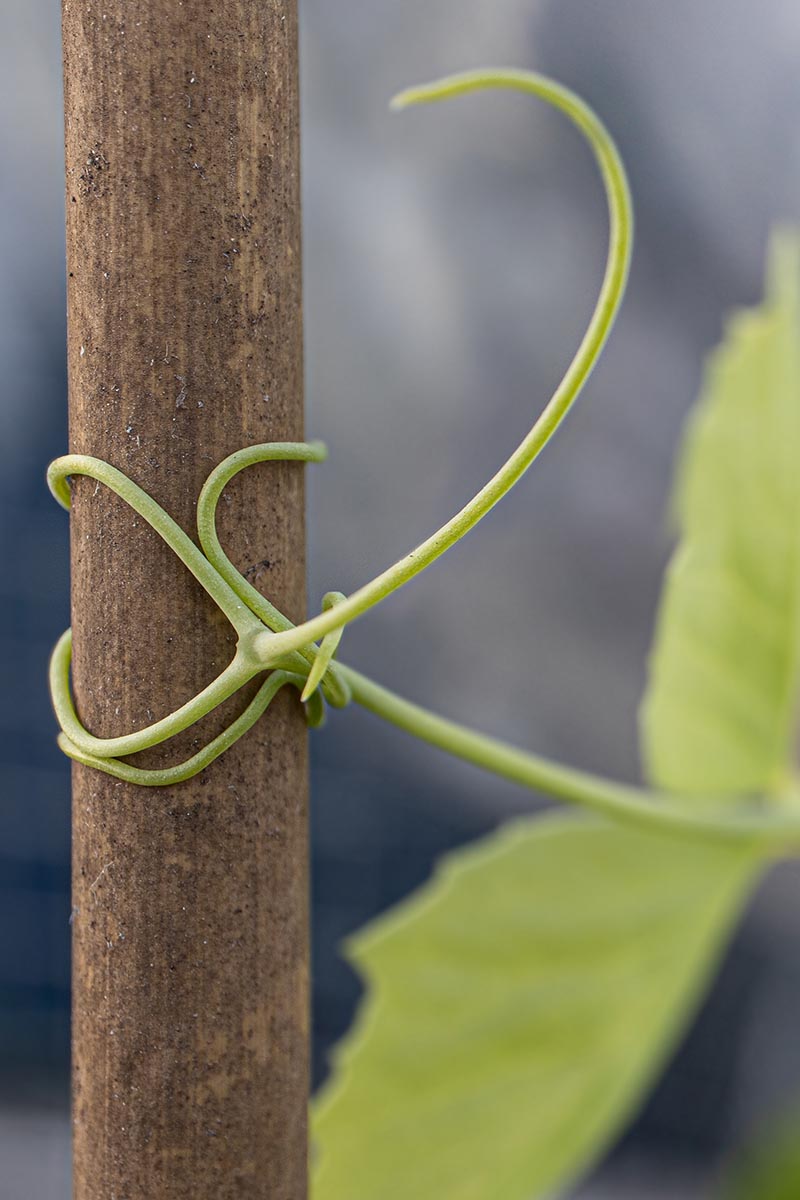
Give them full sun in cool weather, or give them partial sun with shade in the afternoon heat if you live somewhere that might experience some hot days during the growing season.
You can provide the plant something to grow and vine up to be as healthy as possible, though the requirements here are pretty loose. You can plant yours against a fence or a trellis, or train it up wires. I go the lazy route and plant them in the middle of a tomato cage.
In case you aren’t familiar with pea growth habits, there are either bush or vining types. Bush types can grow without a trellis, and they can support themselves. Vining types need something to grow up or they’ll collapse and turn into a big mess.
You can let these plants grow naturally without support since they’re bushing types, but this often reduces the amount of sun they receive and makes them more susceptible to fungal diseases and pests.
When it comes to water, peas like a good amount of moisture. The soil should remain moist but not wet the entire time the plant is growing.
Drought at any point can stunt the plant, reduce yields, or cause the plant to “bolt” and turn tough, causing pods to fill out and become less palatable.
If you were to stick your finger into the soil, it should feel moist like a well-wrung-out sponge. If it feels soggier, don’t water. If it feels drier, add water right away.
Growing Tips
- Plant in full sun, or afternoon shade in warmer climates.
- Provide plants some support.
- Provide consistent moisture.
Where to Buy
As we mentioned, this is an extremely popular pea option. You shouldn’t have too hard of a time finding it, sometimes as live plants, but more often as seed.
For example, Burpee carries packets of 300, 900, and 2,000 organic seeds.
If you’re looking for a resource that carries more size options, check out High Mowing Organic Seed. They have ounce, half-pound, pound, five-pound, and 20-pound options.
If having the choice between conventional and organic is important to you, Botanical Interests carries 25-gram and 15-gram packets, respectively.
Maintenance
Oregon sugarpods don’t require any maintenance. You can literally plant them and watch them grow.
However, to be a good helicopter parent, pinch the plant when it’s young to encourage branching.
There’s no need to provide fertilizer or do any pruning. Cut off any branches that break since they’ll just weigh the plant down.
Managing Pests and Disease
I’ve found that herbivores are the biggest threat when growing these peas. Pests are rare, and diseases are even more rare.
Herbivores
The entire plant is edible, including the leaves, stems, and flowers. You know who loves to eat all these parts before the peas even form? Herbivores like birds, rabbits, and deer.
Birds
Birds seem to like to nibble here and there on mature plants, but the big risk is to tiny plants. Our avian friends can mow through an entire seedling in no time flat.
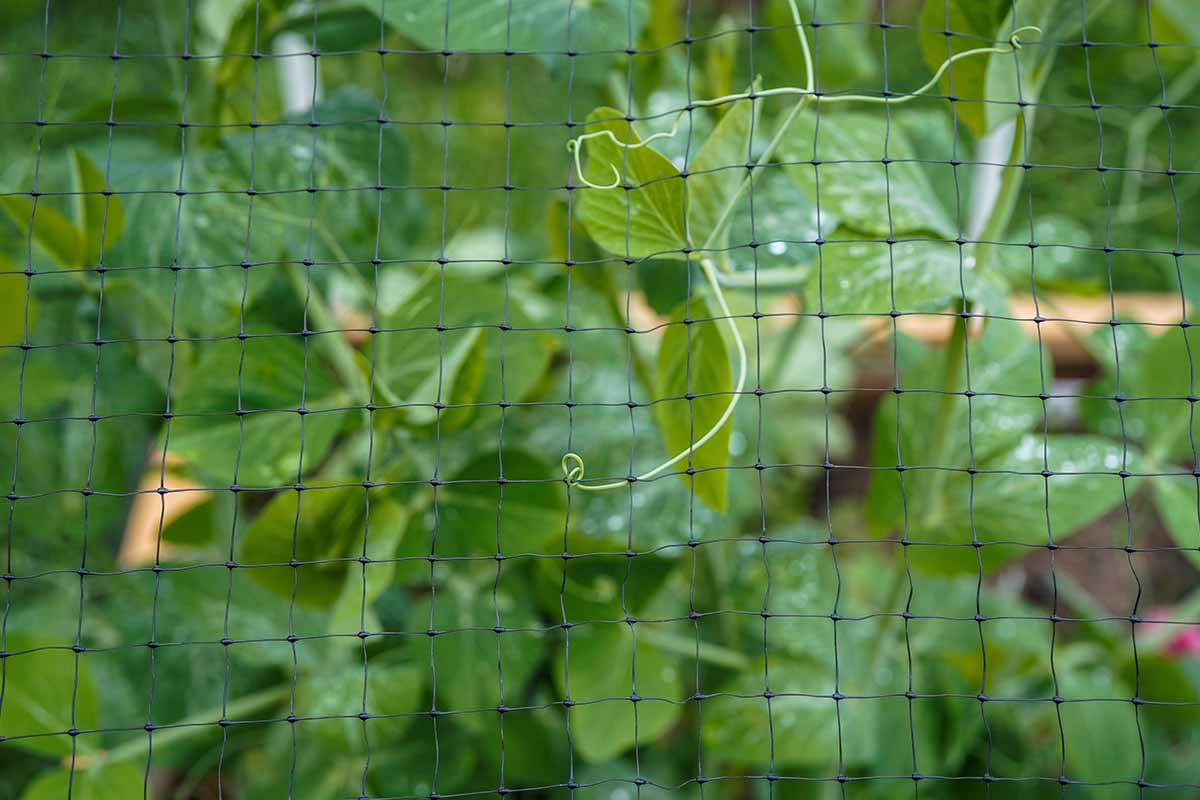
If you have an active bird population, try drawing them away with feeders or sacrificial plants.
Then, protect the young plants with netting until they’re big enough to hold their own.
Deer
There are some plants that the deer in my neighborhood seem to treat like most kids treat spinach. They’ll eat it if they have to, but they’d prefer the chicken nuggets on their plate.
Peas are deer chicken nuggets.
That shouldn’t be a surprise since many people feed pea family (Fabaceae) plants as forage to lots of different ungulate species.
Our guide to deer-proofing your garden can help you protect those vulnerable plants.
Rabbits
The biggest challenger to deer in the pea-eating department are rabbits. They love the plants just as much as deer do, and they’re much wilier about getting to the goods.
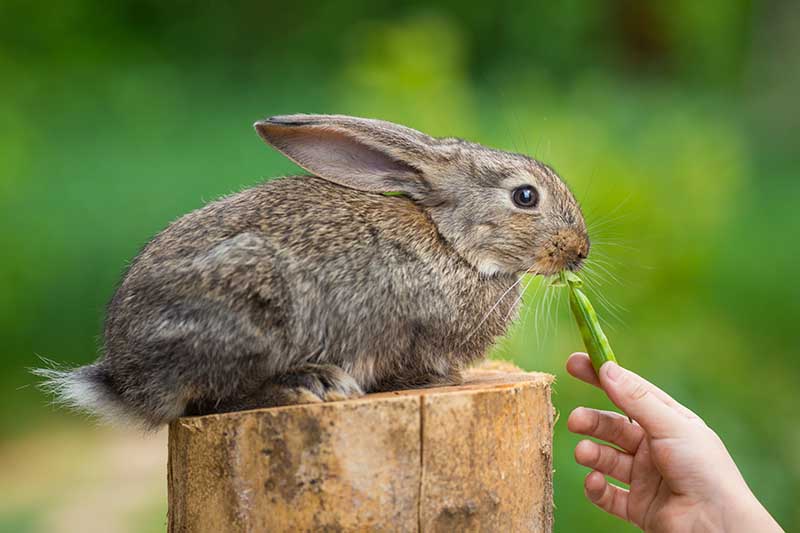
If you’re regularly troubled by rabbits in your garden, I’d highly recommend that you grow your peas in a container. It will save you a lot of trouble down the road.
Then, visit our guide on how to keep rabbits out of your garden to help make things easier on yourself in the future.
Insects
While it’s a disease-resistant superstar, Oregon sugarpod isn’t immune to insect pests.
Aphids
Pea aphids (Acyrthosiphon pisum) and blue alfalfa aphids (A. kondoi) feed on various types of legumes and exist across the world.
If you see tiny green or pink, oval-shaped critters crawling on your pea plants, it’s probably one of these.

A few insects will cause a little leaf yellowing, but large populations, which tend to form in the spring and fall, will cause the plant to wilt and collapse as the aphids use their sucking mouthparts to feed.
While aphids exist and feed in every garden, it’s only when there’s some sort of imbalance that aphid populations typically grow out of control.
Usually, you’ll see it when there aren’t enough natural predators to keep populations under control.
For now, treat the problem by following the tips in our guide to aphids. Then, work on creating a healthier garden to prevent future issues.
Armyworms
There are multiple armyworm species that feed on peas and other legumes, including beet (Spodoptera exigua), Bertha (Mamestra configurata), and western yellow-striped armyworms, (S. praeica). But the species doesn’t matter – they all do the same type of damage.

The adults look like brown moths, and while their presence is a warning that they’re around, it’s the larvae that you need to worry about.
They’re active at night, crawling up to feed on the tender new growth, so it can be hard to tell if they’re around until it’s too late. There can be multiple generations per year, so you have to be vigilant whether you’re growing in spring or fall.
They’re much more active in gardens with lots of weeds because it gives them places to hide and for the adults to lay eggs. Yet another reason why you must control those weeds!
If you have just a few plants, head outside and lightly turn the surface of the soil. You’ll uncover some of the larvae. Just pluck them up and toss them in some soapy water.
Do this every day, and you should have the situation under control in about a week.
For larger gardens, take a multi-pronged approach. Buy some Trichogramma wasps and introduce them to your garden.
They’re an effective predator that won’t eliminate the larvae but will seriously reduce their numbers.
You can grab tabs, cards, or bulk orders of the wasp eggs from Arbico Organics, depending on how large your garden is and how big your infestation is.
Cutworms
Black (Agotis ipsilon) and variegated (Peridroma saucia) cutworms are similar to armyworms, except they cut the plant off at the base rather than crawling up the plants and eating the tender new growth.
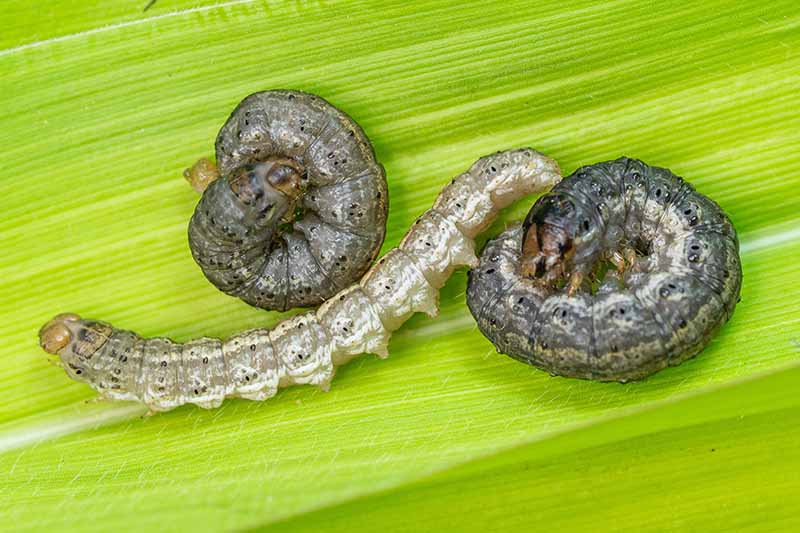
If you’ve ever woken up one morning to head out to your garden only to find that your plants have collapsed, severed at the base, then you’ve met cutworms before.
Hand plucking, as described for armyworms, is an effective control method, but you’ll want to add an extra step to protect your plants until you can kill the little crawly jerks.
Protect your peas with collars as described in our guide to controlling cutworms. The guide also has more information on how to control larger infestations.
Weevils
Two weevil species feed on pea plants: pea leaf (Sitona lineata) and pea weevils (Bruchus pisorum).
The adults of the latter species eat the blossoms, while their larvae eat the peas inside the pods. Pea leaf weevils eat the leaves, which is really only a problem for young seedlings.
Since both look similar, brownish and about a quarter-inch long, you can tell them apart by looking at what part of the plant they’re feeding on. Just hand pluck any you find.
If you start plants indoors or buy seedlings, you won’t need to worry about pea leaf weevils.
For pea weevils, insecticides don’t work well. Your best bet is to handpick any adults you see and plant as early in the year as you can manage to avoid them.
You should also read our guide to learn all about these pests and how to deal with them.
Disease
While you can safely sit back and not worry about most disease problems with this plant, it’s not totally immune to everything. Sorry!
While it is resistant to fungal issues, there are some other potential ailments that aren’t fungal in nature to keep an eye on.
Bacterial Blight
Pseudomonas syringae is one of the most common pathogens that attacks plants.
The pathovars, or bacterial strains, pisi and syringae, in particular, infect peas and other legumes, causing water-soaked lesions on the leaves and stems that can eventually lead to rot and death.
There isn’t any known treatment that’s effective, but crop rotation and buying disease-free seed helps with prevention.
Harvesting
Typically, the pods are plucked when they’re only slightly lumpy before the seeds inside grow plump, but you can also wait until the seeds grow a bit larger.
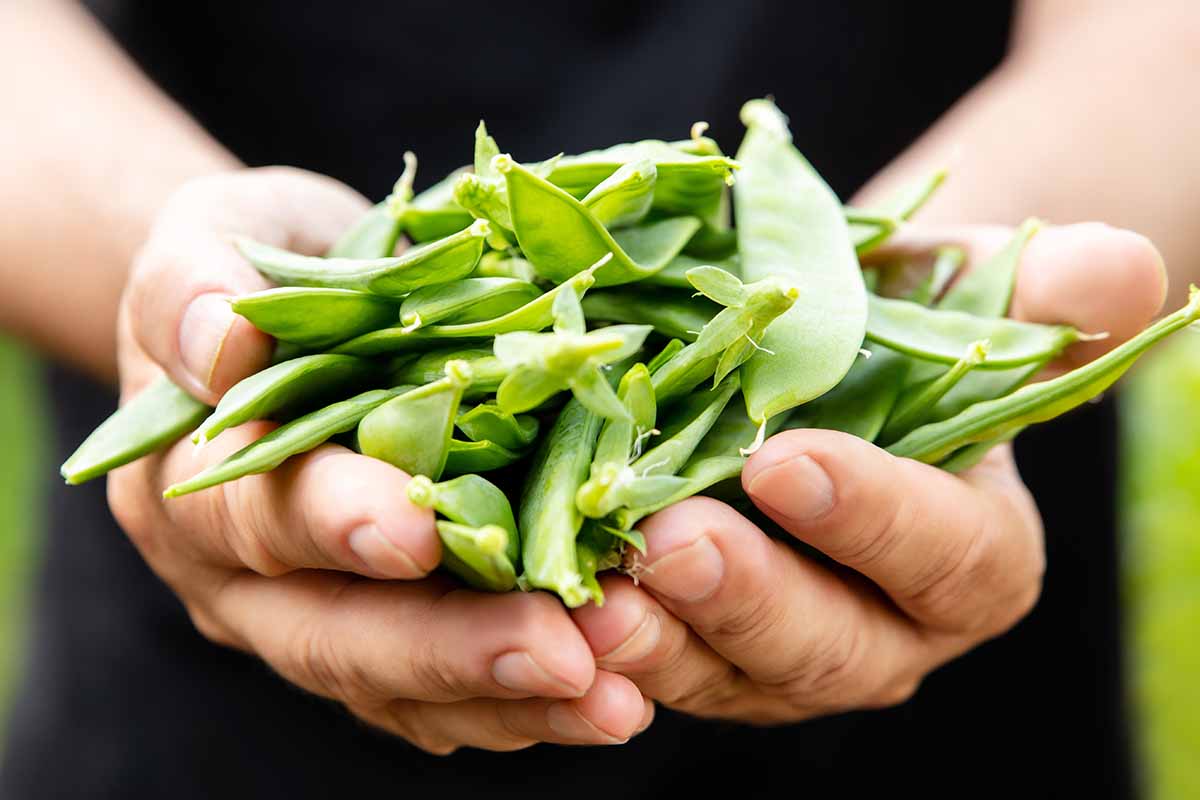
As they mature, the pods and seeds become tougher and less sweet, so find the level you prefer.
Don’t wait for the peas to become large as you might do with English peas. They won’t ever grow that large. We grow these plants for the edible pods, not the seeds.
To harvest, pinch the pods off at the base or snip them with a sharp pair of scissors.
I also find the flowers to be some of the tastiest that I’ve tried. Just know that for each flower you pluck, that’s one less pod you’ll have, so don’t overdo it. Just pinch them off when they’re young.
Preserving
These peas were literally bred to be frozen. To freeze them, wash and dry them and lay them on a tray.

You want to make sure they’re arranged in a single layer on the tray and not piled up in a mass, or they won’t be as crispy when you thaw them out.
Put them in the freezer. Once they’re frozen solid, pack them into resealable bags or jars.
You can also can them. If you’ve never canned homegrown produce before, our sister site Foodal has a guide to walk you through the process.
Recipes and Cooking Ideas
The options for using peas are pretty endless. Stir fries, soups, salads – you name it, and they’re great in it. Even desserts like ice cream and cakes can be made with peas!
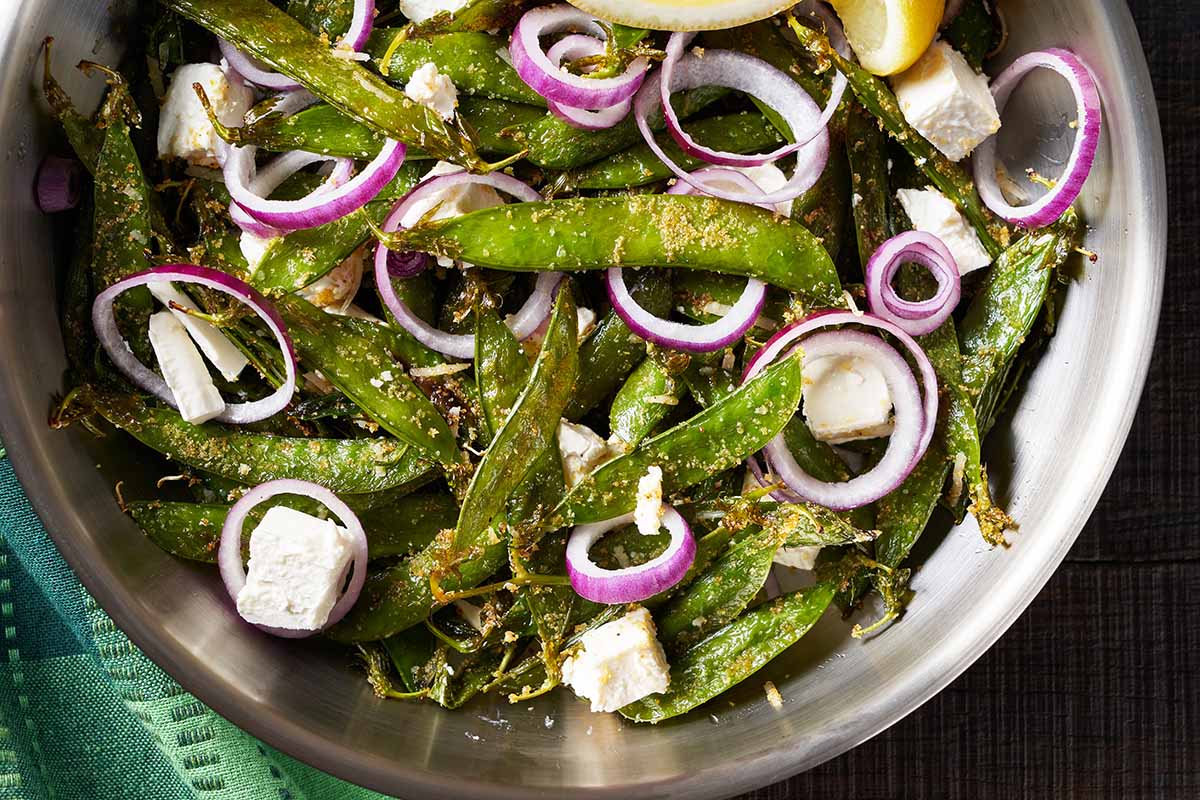
Make a spring meal with this asparagus and snow pea black-eyed pea salad from Foodal. Or green up your summer meals by adding them to pasta, like what you’ll see in this recipe from Foodal.
Quick Reference Growing Guide
| Plant Type: | Herbaceous vegetable | Flower/Foliage Color: | White/medium green |
| Native to: | Middle East | Tolerance: | Some shade |
| Hardiness (USDA Zone): | 3-10 | Soil Type: | Loose, rich |
| Bloom Time/Season: | Spring, fall | Soil pH: | 5.5-7.0 |
| Exposure: | Full sun, partial sun | Soil Drainage: | Well-draining |
| Time to Maturity: | 56 days | Attracts: | Bees, butterfiles |
| Spacing: | 3 inches | Companion Planting: | Beans, carrots, cucumbers, eggplant, lettuce, peppers, radishes, spinach, turnips |
| Planting Depth: | 1 inch (seed), same as container (seedlings) | Avoid Planting With: | Alliums like onions, garlic, leeks, chives |
| Height: | 30 inches | Order: | Fabales |
| Spread: | 6 inches | Family: | Fabaceae |
| Water Needs: | Moderate | Genus: | Pisum |
| Growth Rate: | Fast | Species: | Sativum |
| Maintenance: | Low | Variety: | Macrocarpon |
| Common Pests and Diseases: | Aphids, armyworms, birds, cutworms, deer, rabbits, weevils; bacterial blight | Cultivar: | Oregon Sugar Pod II |
Oregon Sugar Pod Peas
If you love sugar snap peas, I can’t think of a single reason not to grow ‘Oregon Sugar Pod II.’ It’s fast-growing, disease-resistant, and doesn’t require support.

But none of that comes at the expense of flavor or size. The pods are still large and full of flavor.
All that, and they’re open pollinated so you can save the seeds and use them year after year.
What do you plan to do with your harvest? Do you eat them buttered as a side dish? Toss them with other veggies for a stir fry? Share all your favorites with us in the comments!
Ready to learn more about growing peas? We have some super guides worth taking a look at:
